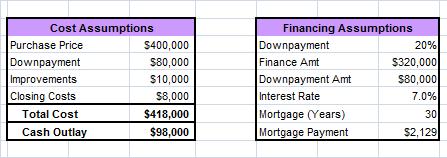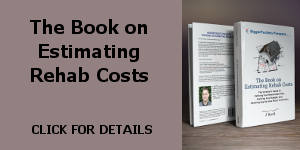Gathering Your Information
The first step in being able to analyze the value of a rental property is to understand what factors contribute to property value. In general, good financial analysis involves being able to input a bunch of information about your investment into a financial model, and have that model kick out a bunch of information that you can then use to determine whether the investment is a good or a bad one (and whether it is the right investment for you).
Below are the very high level inputs necessary to perform a thorough financial analysis of a residential rental property:
- Property Details: This is information about the physical design of the property, including number of units, square footage, utility metering design, etc
- Purchase Information: This is basic cost information about the property you are considering, such as the purchase price, the price of any rehab or improvement work you’ll need to do, etc
- Financing Details: These are the details of the loan you will obtain to finance the property. This includes such things as total loan amount, downpayment amount, interest rate, closing costs, etc
- Income: This the detailed information about the income the property produces, such as rent payments
- Expenses: This is the detailed information about costs of maintaining the property, including such things as property taxes, insurance, maintenance, etc
Getting good data out of your model requires that the information you put into your model is highly reliable and accurate; gathering accurate data can often prove the difference between making the property look great on paper and look horrible.
Pro-Forma vs Actual Data
Remember from the introduction of this tutorial that the value of multi-unit properties is directly related to how much income/profit it produces for its owner. Because of this, it’s often in the seller’s best interest to provide numbers that are more “appealing” than they are accurate; for example, a seller may give high estimates of rental income or neglect to mention certain maintenance expenses to give the impression that the property is more valuable than it is.
So, part of your job is to make sure you have the best information available when doing your financial analysis.
How do you do that, you might ask?
Well, while you may rely on “pro-forma” data (basically, pro-forma means “estimated”) from the seller to kick off a discussion about a property, you should ensure that before you actually close on the property that you get actual data about income and expenses. You should ask to see previous years tax returns, property tax bills, maintenance records, etc. Hopefully all the actuals will prove similar to the pro-forma data you had previously been given, but don’t be surprised if it doesn’t. Remember, the seller is trying to make a sale, and will oftentimes get creative to make the numbers seem better than they are.
In addition to getting actual data from the seller, you should do your best to ensure there are no surprises if you were to buy the place. For example, when was the last time the property was assessed for taxes? If it was a while ago, and values have increased significantly since then, it’s possible that the property will be reassessed very soon, and property taxes will increase. Remember, even small changes to the income and expense numbers can mean big changes in your bottom line.
Where to find your data
In terms of the input data we discussed above, here is where you should be looking for each of these:
- Property Details: This information should be available from the seller, but more comprehensive and detailed information can also be obtained from your local County Records Office
- Purchase Information: Obviously the seller is going to name a purchase price (which will likely be negotiable, of course), but the more important information here will be any upfront maintenance or improvement work that needs to be completed to ensure that the property can (or continue to) meet its income potential. While there may be no extra cost here for properties in good condition, it’s worth having the property inspected by a professional building inspector to ensure that there are no hidden issues or problems
- Financing Details: You’ll want to talk to your lender or mortgage broker to get an idea (or better yet a letter of approval) about the cost of the loan and the necessary downpayment
- Income: Details about income should come directly from the seller, but as mentioned above, don’t rely on pro-forma data for final analysis. You can also talk to the property management company currently running the property (if there is one) to get this information
- Expenses: Similar to income, details about expenses should come directly from the seller (last warning not to trust pro-forma data!) or the property management company currently running the property. This is another place where a building inspector could help warn you about any major repairs that may be coming due in the near future (new roof, new heating/AC, etc)
Example Property
While it will be your responsibility to do your own due diligence in gathering the necessary data when it comes to evaluating real properties, I’m going to take the liberty to create a fictitious apartment building for sale to use as an example for this tutorial.
Here are the high-level details on the building (click here to download flyer)…
For reference, this is similar to what a seller might provide in terms of pro-forma data on a property for sale (though a good seller would hopefully have something a little more professional looking).
Example Financing
The flyer above contains most of the data you’ll need for this analysis (though again, remember that this is just pro-forma data; you’ll want actual data before signing any contracts). The one thing the the seller can’t tell you is what your financing will look like for your property; that’s something you’ll need to determine with your lender or mortgage broker. For the sake of this example, let’s assume we’ve also spoken with our lender, and have secured a loan with the following properties:
- Price: As listed in the flyer
- Improvements: $10,000, as listed in the flyer
- Finance Amount: 80% of total cost
- Interest Rate: Fixed 7% over 30 years
- Closing costs: 2% of total property cost
Based on that here are the calculations we’ll need later in our analysis:

Now, using this fictitious building and our assumed financing options, let’s jump into our analysis!




Leave a Reply